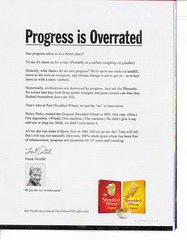Putting the no in innovation
is a new advertising campaign for Post Shredded Wheat cereal. I saw a tv commercial for it last weekend and I thought it was a good title for a followup to last week's piece on creating a great active park-recreation-museums-civic place at Poplar Point to reenergize East of the River planning, leverage subway access, leverage the Anacostia River, and proximity to the Nationals baseball stadium etc.
Christopher mentioned how the Golden Gate National Recreation Area, a National Park Service multi-site installation in the San Francisco Bay area, is pretty innovative, particularly in the adaptive reuse program for the Presidio.
I countered with the story of the Army Corps of Engineers' arboretum at Chittenden Locks in Seattle. Horticulturist Carl English took advantage of being at a federal facility located 3000 miles away from Washington, DC and not being managed and monitored too closely to create a fabulous botanical garden. He wouldn't have been able to do that if he had been located east of the Mississippi River...
Similarly, it is likely that the GGNRA has an advantage being located 3,000 miles away from the headquarters of the National Park Service. See this interesting webpage from the Corporate Design Foundation about the development of a solid branding and repositioning campaign for the GGNRA, sponsored by the independent Golden Gate National Parks Conservancy.
Not to mention the Presidio Trust website, which has a fascinating description of how this installation is managed and operated:
Because of the Presidio’s city-like infrastructure, its nearly 800 buildings, and its expansive cultivated forest and natural areas, funding the Presidio’s operation and long-term care is much more costly than traditional parks. In 1996, Congress devised a management and funding model unique among national parks, and created the Presidio Trust to preserve the Presidio’s natural, scenic, cultural, and recreational resources, and to become financially self-sufficient. The Trust manages the interior 80 percent of Presidio lands (known as Area B), including most buildings and infrastructure.
The Trust receives federal appropriations that diminish each year, and cease at the end of fiscal year 2012. The Trust uses these funds and lease revenues to rehabilitate the park's buildings, restore its open spaces and historic resources, provide programs for visitors, maintain utilities and infrastructure, and fund the Presidio’s long-term care.
Sadly, DC doesn't have the kind of "out of site, out of mind" advantage possessed by places located on the West Coast, when it comes to dealing with agencies of the federal government.
Otherwise maybe something exciting could happen at Poplar Point, other than some more open space and some office and residential buildings and a water taxi dock.
------
For an interesting piece on a similar issue in Boston, about how to develop a site freed up by the Boston Big Dig and the creation of the Boston Greenway, see this editorial from the Boston Globe, "Getting to 'wow!' on Greenway" about competing proposals for Parcel 9. Most of the commercial proposals include a kind of public market on the ground floor. Another proposal puts forth the idea of a city museum with lots of good gaws.
If they had more land like at Poplar Point, they could do both.
Labels: change-innovation-transformation, parks, rivers and waterfronts, urban design/placemaking




0 Comments:
Post a Comment
<< Home